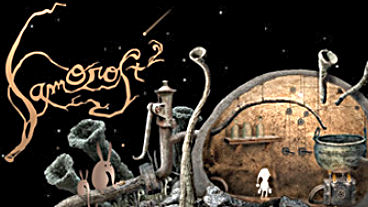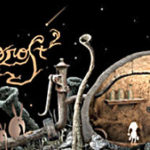
Samorost 2







Back in 2003, Czech-born Jakub Dvorsky released his art school thesis project titled Samorost as a free online flash adventure game. Little did he expect that the game would soon become so popular, it would crash his friend’s server where it was hosted. Blending surreal Monty Python-esque visuals with a hauntingly compelling soundtrack, Samorost told the story of a space gnome attempting to save the asteroid he lived on from imminent collision with an approaching space-rock. The simple yet remarkably fun game involved guiding the gnome through a highly imaginative world by interacting with mechanical contraptions and vibrant life-forms spread across the space-rock environment.
Samorost 2 is the eagerly awaited next installment in the series from Jakub and his small team at Amanita Design. The sequel takes you back to the enchanting world of the space gnome, and begins dramatically with aliens landing in his backyard one evening, stealing fruits from his tree and then abducting his faithful doggie companion after he tries to alert his master. Awoken by the commotion outside, the stunned gnome soon realizes what has transpired and promptly hops into his spaceship (still in his white pajamas and nightcap) to pursue the aliens back to their home planet. From there on, it’s up to you to guide him through the alien world, rescue his beloved dog and return home safely.
One of the first things that made me sit up and take notice of Samorost 2 was the quality of its visuals, which are absolutely gorgeous and very unique in style. The alien environments are whimsical and highly imaginative, evoking misty eyed recollections of Neverhood and Bad Mojo. There are also shades of inspiration from the animation sequences from the classic British TV series Monty Python’s Flying Circus thrown in for good measure. The environments are teeming with bizarre creatures and odd gadgets, sometimes moving and at other times inert, waiting for you to interact with them. Strange plants and insects often make an appearance, on a backdrop created using a collage technique from various nature photographs. Interestingly, the term “samorost” in Czech refers to a root or piece of wood which resembles a person. The intensely organic and lively environments in this game almost feel like they are part of a living, breathing entity.
Adding to the atmosphere is the wonderfully original soundtrack which manages to capture the essence of the imaginative worlds. The tempo of the music speeds up at some locations and slows down to create a torpid, dreamlike feel for others. Some locations do not have any music, and the silence is broken only by the sounds from the environment. The quirky sound effects do a good job of capturing the liveliness of the environments and further add depth to an already fascinating world. Incidentally, the music score and sound effects were created by two people sharing the same name of Tomas Dvorak.
Like the original, Samorost 2 presents you with a simple point-and-click interface to control the space gnome and interact with the environment. The gameplay involves solving puzzles on the screen, to enable the gnome to progress to the next screen. Solving the puzzles first requires scouring the screen to locate objects that can be interacted with. This process is facilitated by the mouse pointer, which changes into a hand icon when it passes over an interact-able region on the screen. Clicking on these interact-able regions produces varying, often unpredictable responses.
The key to success in this game is to harness these responses in an appropriate sequence or a timely manner, in order to accomplish a task. For instance, at one location, need to click on a mouse at the precise moment when a bug passes near a spider to make it eat the bug. Once it has eaten the bug, it throws up near the gnome. Then you click on a fly on the screen, which flies over to the bug that was thrown up and starts feeding on it. Next, you click on the gnome, which makes him jump. This disturbs the fly which flies upwards, gets caught in a web and is turned into a cocoon by a spider. Clicking on the gnome makes him latch on to the cocoon and swing over to the next screen.
The simple gameplay in Samorost 2 shuns dialogs and character inventory. Some of the puzzles do require picking up an object and using it. But if anything can be picked up in this game, it is meant to be used somewhere on the same screen. In keeping with the theme of simplicity, there is no option to save your progress. Instead, the game is divided into several levels, each of which has a passcode which is displayed briefly at the start of a level. If you note down the passcode, you can resume playing at the beginning of that level at any time. This might sound like an unwise design decision, but it works because the levels are typically quite short in length.
While I found the simplicity of gameplay appealing, it is not without its drawbacks. One of the aspects that occasionally annoyed me was the dreaded pixel hunting when searching for objects to interact with on the screen. Moving the mouse carefully over every single area on the screen is not exactly my idea of fun, and got me pretty frustrated at times. Still, this is the only criticism I have about the gameplay. The only other reason I have to wag my finger at this game is its length, which is a tad bit on the short side (it took me only 2 – 3 hours to finish the whole game).
To conclude, despite its short length, Samorost 2 is an exceptionally charming and imaginative indie adventure game, offering a highly immersive, interactive experience. Don’t let the simple gameplay fool you – beneath the surface lurk some deceptively challenging puzzles. This point-and-click flash adventure comes in two chapters – the first is free and playable from the developer’s website athttp://www.samorost2.net/. The second chapter is accessible for a fee of $6.90, which then gives you the ability to download the entire game to your computer and play it offline. The nominal fee for the second chapter is definitely worth it, if only to inspire talented folks like the ones at Amanita Design, so that they continue to create such magical, whimsical titles which breathe new life into the adventure genre.

Leave a Reply